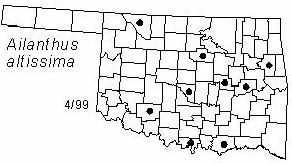Tree to 15 m (50 ft) tall and 30 cm (12 in) diameter, with spreading open crown. Bark light brown to gray, smooth, becoming slightly fissured and roughened on trunks. Twigs light brown, very thick, hairy when young, with thick brown pith. Leaves alternate, pinnately compound, 30-60 cm (1-2 ft) long, often with a disagreeable odor. Leaflets 13-25 or more, short-stalked, broadly lanceolate, 8-13 cm (3-5 in) long and 2.5-5 cm (1-2 in) wide, acuminate, with 2-5 teeth near the falcate base, dark green above, pale green below. Inflorescence branched panicles 15-25 cm (6-10 in) long at ends of leafy twigs. Flowers numerous, small, blooming in late Spring, staminate and pistillate flowers usually on separate trees, staminate flowers with a disagreeable odor. Fruits numerous samaras, about 4 cm (1.5 in) long, reddish brown, narrow, flat, maturing in the Fall and remaining on the tree through most of the Winter.
Distribution: Native to east Asia but naturalized over most of temperate North America.
Habitat: Roadsides, old fields, old homesites.
NWI status: FACU
Comment: Ailanthus is a fast-growing but short-lived tree sometimes planted as a shade tree. It spreads vegetatively by root-suckers and tends to form thickets if not cut back frequently. It is likely to be found almost anywhere in Oklahoma. The map below only shows locations of specimens in the Bebb Herbarium. The genus name Ailanthus is derived from a Chinese word meaning "tree of heaven"; altissima means "very tall".
Distribution in Oklahoma: 
BACK
NEXT
RETURN TO INDEX
Last update: 9/8/99
 Go to Oklahoma Biological Survey Home Page
Go to Oklahoma Biological Survey Home Page
 Disclaimer
Disclaimer